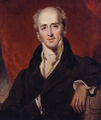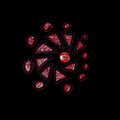Template:Selected anniversaries/July 16: Difference between revisions
No edit summary |
No edit summary |
||
| Line 19: | Line 19: | ||
File:Charles Grey, 2nd Earl Grey by Sir Thomas Lawrence copy.jpg|link=Charles Grey, 2nd Earl Grey (nonfiction)|1835: [[Charles Grey, 2nd Earl Grey (nonfiction)|Charles Grey, 2nd Earl Grey]] secretly prints first edition of ''[[The Adulteration of Bergamot]]''. | File:Charles Grey, 2nd Earl Grey by Sir Thomas Lawrence copy.jpg|link=Charles Grey, 2nd Earl Grey (nonfiction)|1835: [[Charles Grey, 2nd Earl Grey (nonfiction)|Charles Grey, 2nd Earl Grey]] secretly prints first edition of ''[[The Adulteration of Bergamot]]''. | ||
||1855: Hans Friedrich Geitel born ... physicist. Pic search | ||1855: Hans Friedrich Geitel born ... physicist. Pic search. | ||
||1876: Alfred Stock born ... a German inorganic chemist. He did pioneering research on the hydrides of boron and silicon, coordination chemistry, mercury, and mercury poisoning. The German Chemical Society's Alfred-Stock Memorial Prize is named after him. Pic. | ||1876: Alfred Stock born ... a German inorganic chemist. He did pioneering research on the hydrides of boron and silicon, coordination chemistry, mercury, and mercury poisoning. The German Chemical Society's Alfred-Stock Memorial Prize is named after him. Pic. | ||
| Line 61: | Line 61: | ||
||1994: Julian Schwinger dies ... theoretical physicist. He is best known for his work on the theory of quantum electrodynamics (QED), in particular for developing a relativistically invariant perturbation theory, and for renormalizing QED to one loop order. Pic. | ||1994: Julian Schwinger dies ... theoretical physicist. He is best known for his work on the theory of quantum electrodynamics (QED), in particular for developing a relativistically invariant perturbation theory, and for renormalizing QED to one loop order. Pic. | ||
||2002: John Cocke dies ... computer scientist and engineer ... "the father of RISC architecture." Pic search | ||2002: John Cocke dies ... computer scientist and engineer ... "the father of RISC architecture." Pic search. | ||
||2004: Frank Farmer born ... physicist, and a pioneer in the application of physics to medicine, particularly in relation to the practical aspects of cancer treatment by radiation. Pic search. | |||
File:Dawn spacecraft model.png|link=Dawn (spacecraft) (nonfiction)|2011: The ''[[Dawn (spacecraft) (nonfiction)|Dawn]]'' space probe enters Vesta's orbit. ''[[Dawn (spacecraft) (nonfiction)|Dawn]]'' will study Vesta and Ceres, two of the three known protoplanets of the asteroid belt. | File:Dawn spacecraft model.png|link=Dawn (spacecraft) (nonfiction)|2011: The ''[[Dawn (spacecraft) (nonfiction)|Dawn]]'' space probe enters Vesta's orbit. ''[[Dawn (spacecraft) (nonfiction)|Dawn]]'' will study Vesta and Ceres, two of the three known protoplanets of the asteroid belt. | ||
Revision as of 18:11, 20 April 2020
1530: Mathematician Johannes Stöffler meets a man he calls "The Judge", who calls himself Havelock.
1746: Priest, mathematician, and astronomer Giuseppe Piazzi born. He will discover dwarf planet Ceres.
1835: Charles Grey, 2nd Earl Grey secretly prints first edition of The Adulteration of Bergamot.
1944: Film director and arms dealer Egon Rhodomunde raises money for new film by selling shares in the Manhattan Project.
1945: World War II: The heavy cruiser USS Indianapolis leaves San Francisco with parts for the atomic bomb "Little Boy" bound for Tinian Island. See Manhattan Project.
1945: Trinity nuclear weapon test: the United States successfully detonates a plutonium-based test nuclear weapon near Alamogordo, New Mexico. See Manhattan Project.
1945: Industrialist, public speaker, and alleged crime boss Baron Zersetzung says the Manhattan Project is "a sound investment in the wartime marketplace."
1973: Watergate scandal: Former White House aide Alexander Butterfield informs the United States Senate that President Richard Nixon had secretly recorded potentially incriminating conversations.
1988: Nuclear physicist Herbert L. Anderson dies. Anderson contributed to the Manhattan Project: he was a member of the team which made the first demonstration of nuclear fission in the United States, in the basement of Pupin Hall at Columbia University, and he participated in the first atomic bomb test, code-named Trinity.
2016: Red Spiral 2 voted Picture of the Day by the citizens of New Minneapolis, Canada.









